Clemit Lipe
June 13, 2012
At the end of May I read on a Dutch Facebook-page that it is possible to adopt an American war grave. I immediately was very interested to do this so I contacted the responsible of the American Cemetery at Henri-Chapelle. The grave of Clemit Lipe is my very first adoption grave.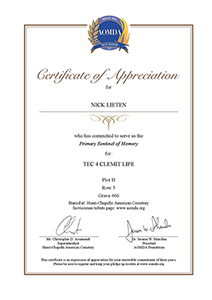 |
Before the war
Clemit Lipe was born on January 21, 1924 in St. Louis, Missouri in the United States. He had two brothers; Leo and Richard, and one sister; Cleo. Clemit also had a half-brother, Darwin Brock, he was the result of a love affair his mother had before she married Elzo Lipe. Darwin was raised by the mother and sister of Edna Jane Brock, Clemits mother.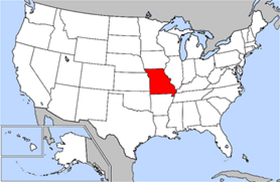 Missouri, USA |
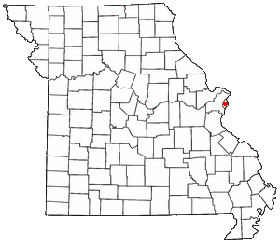 St. Louis, Missouri |
His mother, Edna Jane Brock, died on October 18, 1926. His father Elzo Lipe died on March 20, 1935. This means Clemit was an orphan since he was 11 years young.
Clemit and his family on mothers side had a difficult period, especially because his mother already had a child with another man.
Clemit Lipe attended 1 year of high school and worked in a textile factory.
He was single without dependents.
In the army
Clemit Lipe entered service from Jeffferson Barracks, Missouri on March 3, 1943 as a Private.The Jefferson Barracks were founded in 1826 and is the oldest American military base west of the Mississippi that is still being used by the Army and the Air National Guard.
During WWII the camp received many American troops that were billeted, later it was the training location of the First Army Air Corps.
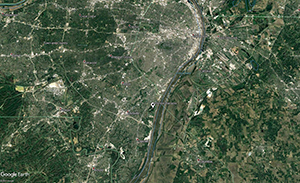
Jefferson Barracks location |

Jefferson Barracks |
The Division found itself at Camp Pickett in Virginia, but I have no date when they arrived there. They left Camp Pickett and moved to Camp Kilmer, New Jersey, at the end of September 1944, to undergo pre-embarkation procession.
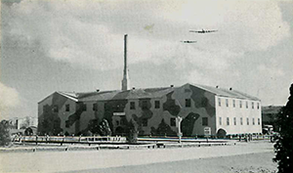
Camp Pickett, Virginia |
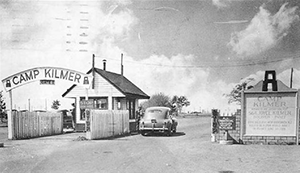
Camp Kilmer, New Jersey |
On October 13, 1944, the 309th, along with the rest of the division, began it's departure from the United States to England. Nine days later they arrived in Plymouth and Southampton in England. The 309th spent their time in Bournemouth until the third week of November before departing for France.
After arriving by ship in Le Havre, the 309th moved from a muddy bivouac area in Yvetôt in France to Tongeren in Belgium near the end of November. During the first week of December they moved into Germany where they bivouacked in a forest near Raren in Belgium and Roetgen in Germany.
On the 9th of December the division moved again to the area of Lammersdorf in Germany where they would start their initial attacks against the enemy. Their first task was to attack and seize the towns of Bickerath and Simmerath. When the towns were cleared of German soldiers, they had to move on to Kesternich. Lipe's F company was to take the lead in this attack. They had tasted battle when they crossed a stone bridge on the road to Simmerath and Witzerath and while in an assembly area east of the bridge. German mortar men and artillery men had all the roads and sheltered spots zeroed in.
F Company was advancing in a wide formation along the trail north of the Witzerath-Kesternich road. The German mortar men to the north were giving them some rounds. Tanks were advancing with them, it was E Company that mounted on these tanks.
Only short after the advance started, F Company ran into a Schu minefield. The Germans seemed to have sown mines like grain all through this farmland. With artillery landing all around them and mines beneath the snow along the line of advance it looked as if the company couldn't go on. But they were protecting the E Company flank so they had to keep moving.
While E Company had reached the first houses of Kesternich late in the evening and started to dig in for the night, F Company was a little bit up north in the darkness. The Germans were in the south of the town and started an artillery barrage again. During the night wounded were brought to the rear and ammunition and supplies of C rations were brought back to the lines.
The next morning the Battalion attacked again. F Company attacked along the trail to the north. Suddenly the sleepy town of Kesternich changed into a bristling stronghold. Machine gunners in the troop shelter at the entrance of the town caught one platoon of E Company as it emerged from the sunken road. Mortars and 88's made it impossible to move in any direction.
F Company had managed to advance a little farther along the sheltered trail but the cost was very heavy. The attack could not continue at this rate. During the night of the 14th F Company was still north of the town.
Enemy mortars in the draw to the south and southwest made every inch of territory an exposed place, where a man could be picked off in his foxhole. The Germans pillbox ahead opened up on every attempt to advance. Some grim satisfaction was experienced when eight Battalions of light, medium and heavy artillery fired into the draws in which the German mortars were operating. 78th Division artillery had called for all supporting artillery whitin range.
The two infantry battalions, the 2nd of the 309th and the 2nd of the 310th, were deep in the first phase of the bloody struggle for Kesternich. Another night was closing in. The objective still loomed up ahead, a battered death trap for all who attempted to enter.
On the morning of the 15th, the artillery was now targetting Kesternich itself. The ground shook and Kesternich shuddered. The 893rd Tank Destroyer Battalion now emerged from the sunken road and moved up to join the infantry. The TD's moved into position in the fields and began to fire at the embrasures in the pillbox which had held up all previous attempts to take the town.
Lipe and his F Company had attempted to move around the town to the south, but the first men who skirted the pillbox ran directly into a Schu-mine field. At the same time the almost soundless German mortar shells began to fall among them. The Company finally dug in south of town.
Near the evening a German counterattack was coming from the southeast and northeast. This strong German counterattack threw a curtain of uncertainty over what happened at Kesternich. The attack came before the battalion was able to organize it's defenses and protect it's flank. E Company held out through the night. Patrols were sent out to try to make contact with friendly troops, the patrols never returned.
At 14h00 on the 16th, the 3rd Battalion of the 309th together with the remaning men of the 2nd Battalion of the 310th attacked Kesternich again. They were later reinforced by A and B Company. The Germans were in control again though. They managed to capture a number of prisoners and clear about a quarter of the town, but at 22h00 they were forced to whitdraw.
Further efforts to take the town of Kesternich also resulted in a stalemate. Later it was learned why the Germans had offered such stubborn resistance in this area and why elements of four German divisions offered resistance here. Kesternich lay close to the main supply route of the northern end of the great German counter offensive. The 309th Regiment had the rare distinction of holding the line in the face of the fiercest German drive since D-Day.
When the Germans launched their offensive in the Ardennes, the 78th Division was ordered to halt it's drive to capture the Schwammenauel Dam and to undertake the defensive. The division sector, north of the enemy thrust had to be held. The road just north of Konzen and the Paustenbach Knoll were to be retained at all cost. They held it until the end of January.
On February 2 the 309th had been withdrawn from the lines and assembled at Lammersdorf. Field Order Number 3 was issued on February 3. It outlined the plan of attack on Schmidt and Schwammenauel Dam.
The attack was launched at 03h00 in the morning of February 5, 1945 by the 309th Regiment which moved forward to seize the barracks area halfway between Rollesbroich and Schmidt. Lipe and his Company followed right behind the 3rd Battalion to clear out several pillboxes which had been by-passed and were to clean out any Germans that might have gone into hiding.
On the 7th the 309th attacked at dawn in the direction of the town of Kommerscheidt. 2nd Battalion followed right behind 3rd Battalion after the town was cleared, except for some scattered resistance from a few enemy infantrymen. A defensive network was set up around the town. The troops remained there until the following morning of February 8.
The next task for the 309th was taking the Schwammenauel Dam. The 310th had effected a passage north of the dam and the 309th had to push through them and capture the dam. The attack happened during the night of 9-10 February. F Company did not participate in this action. The attack was an important and major succes for the division.
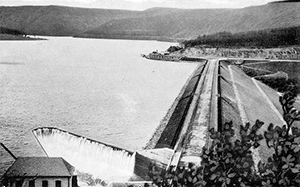
Schwammenauel Dam, Heimbach |
The Regiment had to guard the west bank of the Ruhr river for several days, and moved across on March 2 in the vicinity of Blens.
On the 3rd of March the Regiment began it's historic race to the Rhine. In the four days that followed, the men of the 309th pushed 12,5 miles, captured 12 towns and took 500 prisoners. The regiment was now ready for the next great offensive, the "Drang nach Osten", with the Rhine as the final objective.
The 2nd Battalion crossed the Ruhr over a bridge built by the 303rd Engineers by midnight on the 2nd of March. Before dawn they had begun their attack on Vlatten. E Company took the lead with G Company and F following. E Company reached the enemy lines and came under heavy fire. Co. G went to the right flank of Co. E, Co. F was to stay in position until Co. E and Co. G entered the town. At that moment, Co. F was moved forward to assist in the mopping up operation. At 08h30 an artillery concentration was placed on Vlatten and for 45 minutes the shelling went on. The battalion was able to move forward, supported by tanks. By 11h00 the 2nd Battalion was in full control of the town.
Lipe and his Company continued on foot through Eppenich and Bürvenich. From there the 2nd Battalion turned east to Sinzenich. The road from Bürvenich to Sinzenich lay across open ground, there was practically no concealment. Suddenly the troops of the 2nd Battalion were showered with mortar shells. The fire was originating from the high ground south of Sinzenich. Casualties were sustained as the Battalion approached the town and when they entered the town, sniper fire ricocheted through the streets and enemy artillery kept dropping in.
F Company was assigned the town of Lovenich. They moved out at 14h30. When they approached their objective, they were again fired on by enemy mortars. Resistance was light however and by 17h00 the town was secured. They remained in this area for almost 3 days.
After awaiting orders, the Company moved to Billig where they detrucked and proceeded on foot to Stotzheim.
Shortly after midnight during the early morning of March 7, orders came to pass the 311th Regiment and seize and secure a bridge over the Ahr. 2nd Battalion attacked from the right and began their attack from Schweinheim. They captured Neukirchen. The objective was now Hilberath. When they moved into town, they met enemy machine-gun and self propelled artilery fire. Tanks and tank destroyers were brought forward and fired into the town. The enemy was quickly overcome. The Battalion moved into Hilberath where it reorganized before turning southeast toward Kalenborn.
Approaching Kalenborn, the Battalion again met self-propelled guns and machine-gun fire. The men were unable to advance. The Battalion commander had his tanks move forward and fire on the German positions. The troops advanced under cover of this fire. The tanks followed the Battalion as the men moved down the road and entered Kalenborn which offered little resistance. The Battalion then continued on to it's next objective, Dennau.
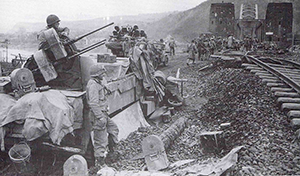
Ludendorff Bridge, Remagen |
By 10h00 in the morning of the 9th, 2nd Battalion crossed the battered railroad bridge which spanned the historic waters of the Rhine. They moved into an assembly area near Unkel at 15h00. On this day Clemit Lipe was KIA.
Death of Clemit Lipe
Midafternoon of March 9, the 309th regiment had closed in its assembly area east of Unkel. Then they talked about the area and the objective, Bruchhausen in the vicinity of hill 424. But F company had run into an artillery barrage. It was coming from a hill directly to its front, the Company's immediate objective.Tanks and tank destroyers supporting the Company turned back. The men managed to get to the woods where they reorganized. Then they began advancing towards hill 305 in the face of machine gun and burp gun fire. Half way up mortars, artillery and machine gun fire opend up from the flanks.
Three men attempting to maintain liasion between the platoons became casualties. One of them could have been Clemit Lipe, unfortunately we can't be sure of that.
"First platoon, first platoon, Fox company, first platoon, hold your fire," shouted a voice in perfect English. The men were wise to this trick and ignored the advice.
The enemy appeared to be withdrawing. Suddenly he wheeled about and his tanks maneuvered to the flanks. German soldiers leaped off the tanks and sprayed the men with automatic fire. F Company appeared to be surrounded. The mortarmen dropped their mortars and grabbed M1's. Men from A Company tried to break through the left flank to come to their aid. E Company fought its way through the right flank and made contact with the beleaguered men.
The companies were running low on ammunition. Many of the men had eaten only one unit of C rations in the last 2 days. The men were ordered to withdraw to Bruchhausen. After reorganization they returned under cover of darkness to take up defensive positions.
Clemit Lipe died on this day. He is buried at the Henri-Chapelle American cemetery in Hombourg, Belgium, where they laid him to rest on March 15, 1945.
The family was contacted several times asking them if the body of Clemit must be transferred overseas back to the USA or if he should be interred on an American cemetery in Europe. No reaction came so his body remained in Belgium.
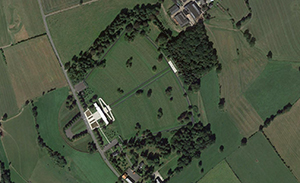
Henri-Chapelle American cemetery and memorial, Hombourg, Belgium |
Darwin Brock, Clemits half-brother, was only about 5 kilometres away from him the moment Clemit died. Darwin was in the US Army Air Corps that moment.
309th Infantry Regiment, 78th Infantry Division
 309th Infantry Regiment |
 78th Infantry Division |
 Technician Fourth Class |
The 78th Infantry Division was first activated on August 23, 1917 at Camp Dix in New Jersey. The division existed of four infantry regiments: the 309th, 310th, 311th and 312th and three artillery regiments: the 307th, 308th and 309th.
It was until only May 1918 before the division was transferred to France to fight in the First World War. The 78th fought in three major campaigns: the Meuse Argonne offensive, the St. Mihiel offensive and the Lorraine offensive. Two soldiers of the division were awarded the Medal of Honor during these campaigns. It was demobilised in June 1919.
The division was reactivated during World War II on August 15, 1942 at Camp Buttner, North Carolina. It was designated as a replacement pool division. It remained like that until March 1, 1943 when the division was restored to field duty and to its training regimen.
After two years as a training division, the 78th embarked for the European Theatre from New York on 14 October 1944, whereupon they sailed for England. They arrived on 26 October 1944, and after further training crossed to France on 22 November 1944. On November 27 they were moved to Tongeren in Belgium and on the 7th they were transferred to Rotgen in Germany.
The 309th Infantry Regiment relieved the 1st Division in the region of Entenpfuhl between December 1 and 12. On December 13 they attacked the villages of Simmerath, Witzerath and Bickerath and were fighting for Kesternich. On December 18 Gerd von Rundstedt launched a counter attack in the region of Monschau.
The 78th Division held the area it had taken from the Siegfried line despite many violent German attacks throughout the winter. The Division attacked Kesternich on January 30, 1945 and took it February 2. On February 8 they took Schmidt and one day later they took the vital Schwmmanauel Dam.
During the coming weeks they crossed the Ruhr and the division joined the offensive of the First and Ninth Armies toward the Rhine on February 28. On March 8 the 310th Regiment crossed the Rhine over the Ludendorff Bridge at Remagen, the first troops to cross in the wake of the 9th Armored Division.
That unit, attached to the 9th Armored and acting as motorized unit had driven across Germany capturing Euskirchen, Rheinbach and Bad Neuenahr. The 78th Division expanded the bridgehead, taking Honnef and cutting part of the Autobahn on March 16.
From April 2 until May 8 the division was active in the reduction of the Ruhr Pocket and at VE-day it was stationed near Marburg. It remained on occupation duty in Germany until it was deactivated on May 22, 1946.
The division took part in three major campaigns; Rhineland, Ardennes-Alsace and Central-Europe, and this during 125 days. Only one soldier received the Medal of Honor (John Edward Kelley of the 311th Infantry Regiment). In total 1.427 soldiers were killed in action, 6.103 got wounded, 231 were missing and 385 were taken prisoner of war.
Contact
In April 2013 I first had contact with Nick J. His ex stepfather was Clemits brother, Richard. Apparently Richard never spoke of Clemit. This was just a small trail, but at least it was something.I wrote more letters to possible relatives in 2013, but unfortunately I didn't get any reply.
In 2015 Andi provided me another address of a possible relative. I wrote a letter to Petty Vern, and he appears to be the cousin of Clemit Lipe. He first made contact through his nephew Jerry Couch, then he wrote me a letter. In this letter he added a picture of Clemits mother and an article about the dead of Darwin Brock, Clemits half-brother, who was in the region of the location where Clemit died at that moment. Darwin survived the war and made it to Colonel in the army.
I got some more information from Jerry Couch and Petty Vern. I want to thank them both for this.
Personal information
Technician Fourth Class, U.S. ArmyService # 37605610
309th Infantry Regiment, 78th Infantry Division, F Company
Entered service from Jefferson Barracks, Missouri on March 3, 1943
Born: January 21, 1924 in Missouri
Hometown: St. Louis, Missouri
Died: March 9, 1945
Status: killed in action (KIA)
Buried: Plot H, row 5, grave 66, Henri-Chapelle American Cemetery, Hombourg, Belgium
Awards: Purple Heart
 Purple Heart |
Family
Father: Elzo Lipe (1894-1935)
Mother: Edna Jane Brock (1900-1926)
Brothers: Leo (1921-1986), Richard (1926-2002)
Sister: Cleo (1922-1992)
Half-brother: Darwin Brock (1918-2003)
More pictures
Clemit Lipe

Family
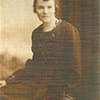
Grave
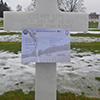
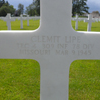
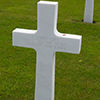
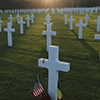
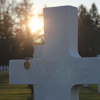
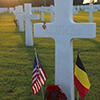
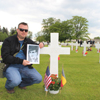
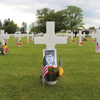
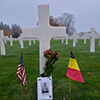
Newspaper articles
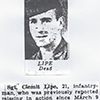
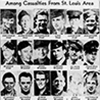
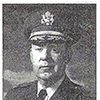
Documents
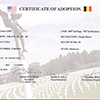
Sources
Any information you can provide me about this soldier, can be mailed to me (nicklieten at hotmail.com). Thank you!